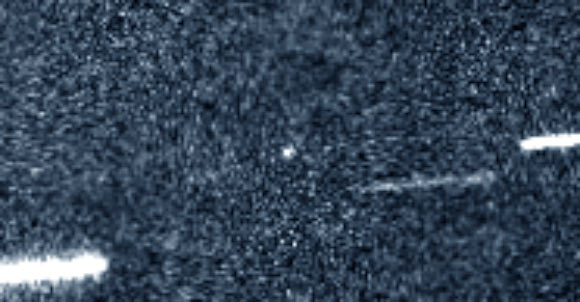On October 20th, when the Pan-STARRS detected a dim 20th magnitude object, nobody realized this object may be unique. Today, with more than 70 observations of this small object, there is no more doubt about it: A/2017 U1 (PanSTARRS) is the first ever observed interstellar asteroid since mankind observes the sky. A breakthrough discovery!

On October 20th, the Pan-STARRS (Panoramic Survey Telescope and Rapid Response System) detected a dim point of light, quickly denominated P10Ee5V, and for which additional observations were required to determine the orbit. After more than 30 of those observations were performed, something strange was noticed with this object by Bill Gray… Seen the trajectory, and mainly its high inclination (around 122°), it first looked like a comet, which explains why it was first named C/2017 U1 (PanSTARRS) by the MPC (Minor Planet Center). But more surprising, its calculated incoming speed was more than 25 km/s, and its eccentricity was highly hyperbolic (first estimated close to 1.2)… which seemed to indicate it did not originate from our Solar System, but from the interstellar medium.
Observations then went on, allowing a more accurate trajectory. But they also showed no evidence of a coma nor a tail: the object definitely proved not being a comet, but more an asteroid-type object, which explain why it was renamed by the MPC a few hours later as A/2017 U1 (PanSTARRS).
Today, its orbital elements are far better defined, after nearly 70 observations were performed. The inclination of A/2017 U1 was defined to be 122.6°, its eccentricity to 1.19 and its incoming speed to 26.17 +/- 0.06 km/s. It reached perihelion on September 9th at a 37,6 millions kilometers distance from the Sun, and was then directed in the Earth’s neighborhood, coming as close as 24 millions kilometers of our planet on October 14th, 6 days before it was discovered. Seen the unique origin of the asteroid, astronomers looked for the radiant it seemed to originate from. Calculations determined that A/2017 U1 came from a radiant located close to (R.A. = 18h 41m 25s ; Dec=+34° 15′) coordinates, which is near the actual position of Vega (alpha Lyr). And that it is now directed to a point which coordinates are (R.A. = 23h 51m 30s ; Dec=+24° 47′). It was thus accelerated up to 87.71 km/s while it came at its closest point to our star, and its trajectory was highly diverted.
Asteroid A/2017 U1 (PanSTARRS) trajectory inside the inner Solar System, from Sci-News.com on Vimeo.
Studying such an object is highly valuable, this is why in a few days of time period, astronomers tried to get as much data on it. First to determine its orbit, but they also try to understand its composition, by making spectra of the tiny (around 400 m diameter) object. Which proved to be a difficult task, seen the current dimness of the asteroid (around mag. +22). Data shows that A/2017 U1 looks quite reddish, similar to our Solar System Kuiper Belt objects. Questions remaining deals with the frequency of such events… We were lucky to be close enough to this asteroid to be able to spot it in time. But if it had arrived at its current position one or two weeks before or after, we would not have been able to detect it.
Spectrum of A/2017 U1 obtained on Wednesday night with the @INGLaPalma 4.2m WHT. Colour is red like Kuiper Belt Objects, featureless. pic.twitter.com/utB1sqdjlV
— Alan Fitzsimmons (@FitzsimmonsAlan) October 27, 2017
A/2017 U1 (PanSTARRS) is much larger than a meteoroid, but smaller (meteoroid) particles may also come from the interstellar medium… giving birth to interstellar-originating meteors! Meteor with an apparent interstellar origin have been detected, though not many. But do they really originate from outside the Solar System? The only way to accelerate a hundred-meter large asteroid to the Solar System’s escape speed is through the gravitational force of a big planet (Jupiter-size), influencing its trajectory. For smaller particles, like meteoroids, this can easily be done by the gravitational force of smaller objects. A study by Paul Wiegert shows that a majority of meteoroids with a velocity above our planetary system’s escape speed may well be local meteoroids accelerated by a close approach to a planet. Still, there is no reason to rule out real interstellar meteoroids either. A study by Baggaley in 2000 revealed a concentration of meteoroid flux at interstellar velocities from the region of beta-Pictoris.
Most information given here, and more details, are available on Bill Gray FAQ page regarding A/2017 U1 (PanSTARRS).




 You saw something bright and fast? Like a huge shooting star? Report it: it may be a fireball.
You saw something bright and fast? Like a huge shooting star? Report it: it may be a fireball.  You counted meteors last night? Share your results with us!
You counted meteors last night? Share your results with us!  You took a photo of a meteor or fireball? You have a screenshot of your cam? Share it with us!
You took a photo of a meteor or fireball? You have a screenshot of your cam? Share it with us!  You caught a meteor or fireball on video? Share your video with us!
You caught a meteor or fireball on video? Share your video with us!